UF Dental Research Offers Prospect of Cavity-Free Future
By Connie Daughtry
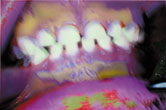
 "Open Wide"
"Open Wide"
Those words used to come laden with anticipation of sharp instruments and foul-tasting solutions.
But research at the University of Florida College of Dentistry could result in dental visits where the sharpest thing going into a patientís mouth is a paint brush. Leading a trend away from "drill and fill," UF dental researchers are developing and testing a host of painless, cost-effective new treatments aimed at preventing the development of cavities from the earliest ages.
One of the most promising of these treatments uses a genetically modified version of a bacterium commonly found in the mouth. Dental researchers have long known that Streptococcus mutans is an agent of destruction for healthy teeth because it converts sugar into enamel-eating, decay-causing lactic acid.
"There is no way to know how much of the worldís tooth decay is caused by Streptococcus mutans," says UF oral biology Professor Jeffrey Hillman. "Most studies suggest that of the 500 or so bacterial species in the mouth, Streptococcus mutans causes the majority of decay."
 So
Hillman genetically tweaked a strain of S. mutans so it does not produce
lactic acid and therefore will not cause decay. He also caused the modified
bacterium ó called an effector strain ó to dominate the naturally occurring
bacterium and block it from colonizing the tooth surface.
So
Hillman genetically tweaked a strain of S. mutans so it does not produce
lactic acid and therefore will not cause decay. He also caused the modified
bacterium ó called an effector strain ó to dominate the naturally occurring
bacterium and block it from colonizing the tooth surface.
Hillman says humans and S. mutans lived in harmony for eons until relatively recently, when our diets began to include more and more refined sugar. That upset the balance, causing the bacterium to make the excessive acid that causes tooth decay.
In another 100,000 years or so, he says, evolution would restore that
balance, producing a bacterium very similar to the one he has engineered.
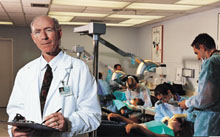
Oral Biology Professor Jeffrey Hillman hopes that one application of the bacteria he has genetically engineered will shield teeth against decay for life. |
"What weíre trying to do with replacement therapy is speed up this natural process," says Hillman, whose research on the problem has been funded primarily by the National Institute of Dental and Craniofacial Research (NIDCR) for two decades. The next step is three phases of clinical trials involving thousands
of human subjects to confirm what laboratory experiments have already shown
for rats: the effector strain is effective in preventing tooth decay and
poses no risk to patients. Hillman hopes the trials, which should take
two to three years to complete, will begin by yearís end.
|
UF has patented Hillmanís technology and licensed it to OraGen, a company Hillman has formed that is based at the universityís Biotechnology Development Institute. Assuming the clinical trials go smoothly, OraGen hopes to have a mouth rinse containing the modified strain of S. mutans on the market in four years.
"The ideal application would be to treat infants when their first teeth appear, although it can be used with older children and adults," Hillman says, adding that clinical trials will help determine if one application is all that is needed for lifetime protection. "If this turns out to be a once-in-a-lifetime treatment, then youíre talking about a really good investment."
While genetic therapies may be the treatment of the future, fluoride remains one of the most effective decay preventatives available today.
UF pediatric dentistry assistant Professor Jaana Autio is studying the effectiveness of a recently approved topical fluoride treatment that protects teeth from decay, as well as promotes remineralization ó a process that reverses early decay.
European dentists have used sodium fluoride varnish as an anti-cavity treatment for 25 years, but the U.S. Food and Drug Administration approved it for the treatment of hypersensitive teeth only in 1997. However, many dentists are legally using the product "off label" for cavity protection.
"Fluoride varnish quickly adheres to teeth and over time is slowly released to the tooth surface, promoting tooth remineralization," says Autio, who is the first researcher in the United States to study the effect fluoride varnish has on cavity progression in primary teeth. Specifically, she studied Duraphat, a varnish manufactured by Colgate-Palmolive, in a group of children aged 3 to 5.
Fluoride varnish takes less than two minutes for a dentist to apply and costs about the same as current fluoride gels and foams. Although it has a higher concentration of fluoride than gels, foams, rinses and pastes, fluoride varnish is less toxic to children because they swallow less of the product during application.
"Fluoride toxicity and its effects, such as nausea, are always a concern with children under 6," Autio says. "Previous studies have shown that fluoride in patientsí blood plasma is lower among fluoride varnish users than users of other topical treatments because less is swallowed."
Autio randomly divided 222 children participating in a Gainesville-area
Head Start program into two groups, one of which received the fluoride
varnish and a control group that received a common fluoride gel.

"We studied the children over a nine-month period in the schools, applying the varnish at the start of the study and at a four-month interval. What we found was the progression of dental cavities had reversed (remineralized) in more than 80 percent of the test group and 37 percent in the control group," Autio said. "The varnish was clearly more beneficial to the children than the gel and reduced the need for expensive fillings."
"Varnish is a parentís dream," says Viviene Crooks of Gainesville, whose 5- and 7-year-old daughters have received the varnish treatment since each was 4 and have not had any cavities. "It was a simple and painless process. To me the experience has left a positive image about going to the dentist for my girls."
Autio, who has been at UF since 1997, used fluoride varnish routinely
in her practice in Finland. Along with other American dentists and organizations
such as the American Dental Association, she thinks all children can benefit
from use of the varnish, especially children from low-income families.
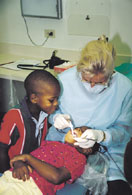
Pediatric dentistry Assistant Professor Jaana Autio found that fluoride varnish was more than twice as effective in promoting remineralization of decaying teeth as flouride gel. |
"Despite the decline in the incidence of dental cavities in the United States, decay and cavities remain a problem among the nationís poor children," says Frank Courts, co-researcher of the UF study and professor and chair of UFís pediatric dentistry department. Another UF researcher is using the Internet to encourage patients and dentists to rethink tooth decay and cavities before they take a course of action. "Through remineralization, early stages of tooth decay can be treated and sometimes even reversed without resorting to fillings," says oral and maxillofacial surgery and diagnostic sciences Professor Douglas Benn. "First the public needs to be educated about the difference between decay and cavity." Many people use the word cavity to mean decay at any stage, but Benn explains that true cavities or holes in the teeth develop very late in the disease process. "A cavity cannot repair itself and needs a filling," Benn says. "On the other hand, decay is a bacterial infection that produces acid that typically, over several years, dissolves calcium from below the tooth surface. Saliva contains calcium that can remineralize or repair the weakened tooth substance, possibly avoiding the need for filling decay in enamel or the outer dentin. Fluoride in toothpaste, drinking water and varnish aids in this repair process." |
"Remineralization is not a new concept to dentistry, but people really donít know that decay doesnít always mean fillings," Benn says. "Once the filling process begins, it leads to replacement fillings that get bigger each time the tooth is filled. On the average, dentists need to replace fillings every eight to 11 years. The final result after many years may be loss of the tooth. Most people donít think ahead about this process."
Bennís approach to preventing fillings not only saves patients money
and anxiety in the short run, it also promotes overall oral health.
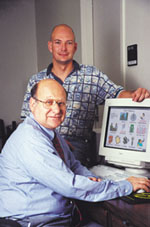
Oral surgery Professor Douglas Benn (seated) and programmer Stephen H. Kostewicz designed a web site to help people understand that cavities are the last stage in the decay process. |
"If dentists can identify tooth decay early in the disease process, they can work with patients to either stop the disease progression or help the tooth repair itself," Benn says. Basic steps patients can take include cutting back on sugar, brushing regularly with a fluoride toothpaste, chewing sugar-free gum three to five times a day and rinsing at night with a fluoride rinse. Dentists also can help by applying fissure sealants (liquid plastic painted on teeth) to protect teeth without cavities and prescribing rinses to kill bacteria. "The bottom line is that many fillings can be avoided altogether or delayed," Benn said. "The result could be a 50- percent reduction in the numbers of fillings needed." Bennís approach has not been without controversy. Some dental professionals initially voiced concern that patients might assume they could care for their own teeth and not visit the dentist routinely. But Benn emphasizes that patients should not assume the role of the dentist and that all patients cannot be treated in the same manner. "Patients must understand that dentists are the only ones who know the health of teeth," Benn said. "Patients can talk to their dentist about keeping an eye on a patch of decay and possibly coming in more often for check-ups and X-rays." At the same time, however, patients must be responsible for their own day-to-day care. "Their dental care habits, diet and visits to the dentist all play a part in their care," Benn said. "If they do not work with the dentist to avoid decay or remineralize the tooth, then the dentistís only option is to recommend filling the tooth." |
Preliminary results from a questionnaire on the site indicate that patients and dentists are willing to have their decay monitored over time to avoid fillings.
"I was previously unfamiliar with the term remineralization, but now
understand what it means from the Web site explanation. I only wish I had
been given this type of information by a dentist years ago," wrote Susan
Gallion of Roswell, Ga., after visiting Bennís Web site. "I do brush my
teeth more often throughout the day now, thanks in part to the UF Web site
and other dental-related Web sites. I intend to use the information to
educate my 12-year-old son, who currently has perfect, cavity-free teeth.
The drawings and photos are invaluable and enhance the text, and the presentation
is good for laypersons and even children, probably age 9 and above. If
a dentist recommends filling a cavity in my sonís mouth sometime in the
future, I will question the recommendation thoroughly and encourage a conservative
approach, due to the knowledge Iíve gained from the Web site."
 |
Dr. Miles E. Kuttler, associate professor of restorative dentistry at Nova Southeastern Universityís College of Dental Medicine, says Bennís site reflects the future of dental education. "He makes a realistic argument for the conservative treatment or non-treatment of dental decay and helps the consumer/patient make informed decisions about their dental health," Kuttler says. |
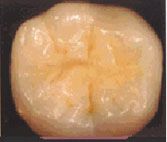 |
"It may take a generation of new dentists to fully implement this medical
approach to dental care. However, it wouldnít be such a bad idea for practicing
dentists and dental auxiliaries to also visit the Web site."
|
 |
"It can be a highly valuable tool for dentists to promote oral health
in clinical practice. It pioneers the dissemination of simple, scientific
and useful dental health information using the Web," Ismail said.
|
Professor of Pediatric Dentistry (352) 392-4131 jautio@dental.ufl.edu |
Frank J. Courts
Associate Professor and Chair of Pediatric Dentistry (352) 392-4131 fcourts@dental.ufl.edu |
Professor of Oral Surgery (352) 392-5210 benn@dental.ufl.edu |
Jeffrey D. Hillman
Professor of Oral Biology (352) 846-0792 jhillman@dental.ufl.edu |